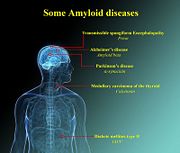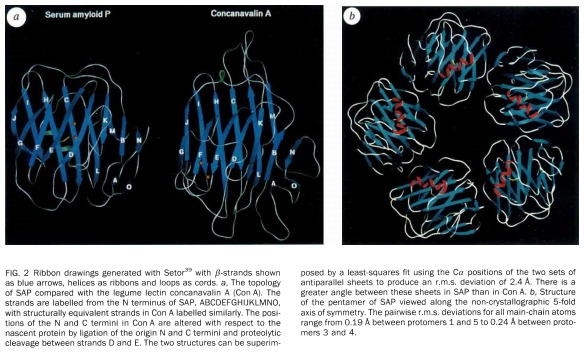User:SarahGrove/Sandbox 1
From Proteopedia
Serum Amyloid P Component
|
Serum amyloid P component (SAP) is a 25kDa pentameric glycoprotein that is present in concentrations between 30-50μg/mL in human serum [1]. As a member of the pentraxin family, SAP shares sequence similarity with C-reactive protein, which is a pentraxin involved in acute phase responses. Proteins belonging to the pentraxin family of plasma proteins have been stably conserved throughout vertebrate evolution [2]. As a result, the structure-function relationship of SAP is very interesting. Thus far, the primary function of SAP has been associated with DNA- and chromatin-binding. It is thought that SAP may scavenge nuclear material released from damaged circulating cells and also function as a calcium-dependent lectin [3].
Contents |
Structure [2]
According to X-ray analysis, the SAP pentamer consists of five subunits of 204 amino-acid residues, each with a very similar three-dimensional structure constructed from antiparallel β-strands arranged in two sheets and a long α-helix between strands L and M. Appropriately, the pentraxin family is characterized by distinctive β-jellyroll structures. The five subunits of SAP are arranged in a ring with a hole 20Å in diameter and 35Å deep at the center. While SAP is most commonly characterized as a pentamer, SAP decamers have also been observed. Unlike the pentamer, though, the decamer is less stable and can be readily dissociated by reducing the pH to 5.5.
Calcium Co-Factor
Several studies have confirmed that SAP has a calcium-binding site, and some have suggested that calcium ligation is likely to be an important local structural determinant. Two large spheres of density which are too heavy to be oxygen atoms and are in positions that imply the presence of calcium ions were identified between 4.0 and 4.3 Å apart in the five subunits. Thus, calcium ions have been recognized as co-factors for SAP. The presence of calcium increases SAP resistance to proteolytic degradation, and all ligand-binding has been proven calcium-dependent at physiological pH and ionic strength.
Potential Functions
Work related to the roles and functions of SAP traces back to the early 1970s. Due to the lack of a natural state of SAP deficiency, it is thought to be an important protein involved in a variety of physiological roles. While reports confirm that SAP is a major calcium-dependent DNA-binding protein in normal serum, there is a lack of evidence explaining the exact functions and reaction mechanisms of SAP. More recent speculations regarding the physiological relevance of SAP have been related to different diseases.
Systemic Amyloidosis [4]

SAP is universally present in amyloid deposits that are characteristic of systemic amyloidosis, which includes cerebral amyloid in Alzheimer’s disease and in type 2 diabetes mellitus [6]. Binding of SAP to amyloid fibrils in vitro protects them from degradation by phagocytic cells and proteolytic enzymes . Consequently, SAP promotes amyloid persistence and contributes to the pathogenesis of amyloidosis. Amyloidosis is a disorder of protein folding which leads to tissue damage and disease. Due to the relationship between SAP and amyloid fibrils, scientists performed a study investigating the impact of targeted depletion of the SAP gene. The results of this study showed a reduced induction of experimental systemic amyloidosis with SAP gene depletion; thus, SAP does indeed contribute to pathogenesis of amyloidosis. Further research is necessary to determine if efficient removal of SAP will reduce the stability of amyloid deposits and prevent diseases associated with amyloid deposition, such as Alzheimer’s disease.
Complement-Mediated Immunity [1]
Because SAP has the ability to bind to pathogen-associated structures such as lipopolysaccharide, data suggest that SAP may assist innate immunity. The results of flow cytometry assays showed that SAP binds to Streptococcus pneumoniae, increases classical pathway-dependent deposition of complement on the bacteria, and improves the efficiency of phagocytosis. Using mice models, infection experiments were also carried out to determine if SAP deficiency would impact an inflammatory response to S. pneumoniae. Since the early inflammation response was significantly impaired by the SAP deficiency, the study concluded that complement deposition, phagocytosis, and control of S. pneumoniae were all improved by complementation with human SAP. Therefore, there is great potential that SAP has an important role in complement-mediated immunity against bacterial pathogens.
References
- ↑ 1.0 1.1 Yuste J, Botto M, Bottoms SE, Brown JS. Serum amyloid P aids complement-mediated immunity to Streptococcus pneumoniae. PLoS Pathog. 2007 Sep 28;3(9):1208-19. PMID:17845072 doi:http://dx.doi.org/10.1371/journal.ppat.0030120
- ↑ 2.0 2.1 2.2 Emsley J, White HE, O'Hara BP, Oliva G, Srinivasan N, Tickle IJ, Blundell TL, Pepys MB, Wood SP. Structure of pentameric human serum amyloid P component. Nature. 1994 Jan 27;367(6461):338-45. PMID:8114934 doi:http://dx.doi.org/10.1038/367338a0
- ↑ http://www.uniprot.org/uniprot/P02743
- ↑ Pepys MB, Herbert J, Hutchinson WL, Tennent GA, Lachmann HJ, Gallimore JR, Lovat LB, Bartfai T, Alanine A, Hertel C, Hoffmann T, Jakob-Roetne R, Norcross RD, Kemp JA, Yamamura K, Suzuki M, Taylor GW, Murray S, Thompson D, Purvis A, Kolstoe S, Wood SP, Hawkins PN. Targeted pharmacological depletion of serum amyloid P component for treatment of human amyloidosis. Nature. 2002 May 16;417(6886):254-9. PMID:12015594 doi:http://dx.doi.org/10.1038/417254a
- ↑ http://rams.biop.lsa.umich.edu/research/amyloid
- ↑ Tennent GA, Lovat LB, Pepys MB. Serum amyloid P component prevents proteolysis of the amyloid fibrils of Alzheimer disease and systemic amyloidosis. Proc Natl Acad Sci U S A. 1995 May 9;92(10):4299-303. PMID:7753801

